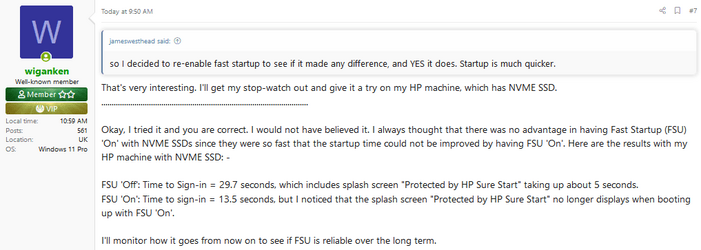I always believed that there was nothing to be gained by having Fast Startup (FSU) 'On' if the OS is on Nvme SSDs but the following thread caused me to check it out: -
 www.elevenforum.com
www.elevenforum.com
Here is photo of my post #7 in that thread: -

Have I been wrong all this time?
Does it matter that the "Protected by HP Sure Start" splash screen no longer has time to display if FSU is 'On'?
Does it mean the "HP Sure Start" protection has not run or has it just not had time to display the splash screen?
Any HP experts out there?
hiberfil.sys and other .sys files not visible in File Explorer despite enabling view of them
Windows 11 Version 23H2 (OS build 22631.2861) I have discovered that it I cannot use file explorer to view the hiberfil.sys, pagefile.sys and swapfile.sys files from with file explorer. I have switched on "show file extension" and "show hidden and system files". I even switched on Developer...
 www.elevenforum.com
www.elevenforum.com
Here is photo of my post #7 in that thread: -

Have I been wrong all this time?
Does it matter that the "Protected by HP Sure Start" splash screen no longer has time to display if FSU is 'On'?
Does it mean the "HP Sure Start" protection has not run or has it just not had time to display the splash screen?
Any HP experts out there?
Attachments
Last edited:
My Computers
System One System Two
-
- OS
- Windows 11 Pro
- Computer type
- PC/Desktop
- Manufacturer/Model
- HP EliteDesk 705 G5
- CPU
- AMD Ryzen 5 Pro 3400GE
- Memory
- 8GB DDR4 SDRAM
- Graphics Card(s)
- Integrated AMD Radeon Vega 11
- Hard Drives
- 256 GB PCIe NVMe M.2 SSD
-
- Operating System
- Windows 11 Home
- Computer type
- Laptop
- Manufacturer/Model
- DELL Inspiron 15-3576
- CPU
- Intel Core i5-8250U
- Memory
- 8 GB DDR4 - 2400 SODIMM
- Graphics card(s)
- Intel UHD Graphics 620
- Hard Drives
- 256GB SK Hynix SC311 SATA SSD







